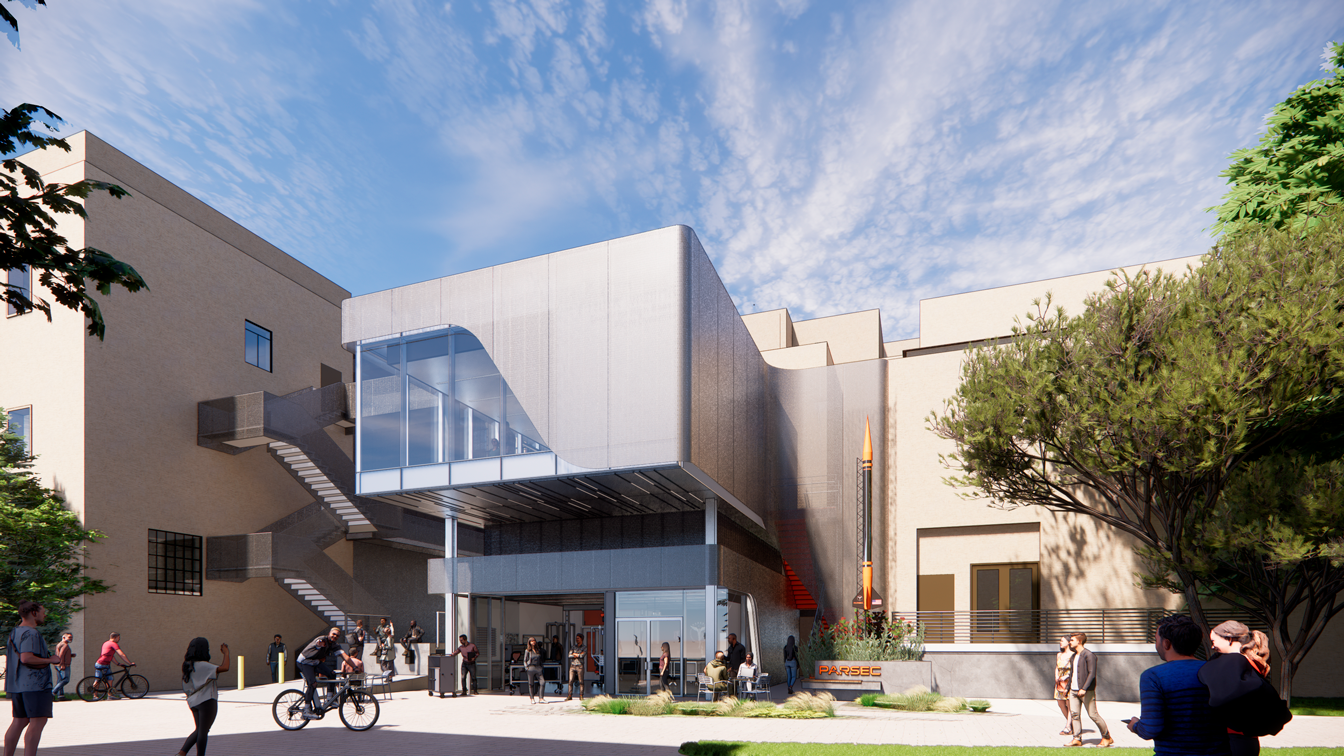The Origins of PARSEC: Propulsion, Aeronautics, and Rocket Systems Engineering at Caltech
An architectural rendering of the new PARSEC facility. Credit: PAGE Architects.
By Julia Ehlert
Nearly 90 years ago, a group of Caltech graduate students and amateur rocket enthusiasts known as the “Suicide Squad” began testing rocket engines under the mentorship of aeronautics pioneer Theodore von Kármán. Their achievements eventually led to the founding of the Jet Propulsion Laboratory (JPL), which Caltech manages for NASA. The Suicide Squad’s adventurous legacy lives on in PARSEC (Propulsion, Aeronautics, and Rocket Systems Engineering at Caltech), a team of students reigniting student rocketry at the Institute, who now have the added boost of a multimillion-dollar gift to help them reach the stars.
Aerospace graduate student Jack Caldwell (BS ’22) and his former roommate Lewis Jones (BS ’20) launched this rocketry revival in 2017, when they conceived of PARSEC as undergraduates. “Lewis and I were talking, and he mentioned another university’s rocket team,” Caldwell says. “I remember asking, ‘Why isn’t there a team here?’”
The two, joined by fellow Blacker House members Alexandra Stutt (BS ’21), Richard Hamel (BS ’20), and Benjamin Cassese (BS ’20), co-founded PARSEC with the goal of building a liquid-propellant rocket and competing in a collegiate rocketry challenge. The COVID-19 pandemic, however, scrapped their plans. Upon graduating, the founding members went on to attend graduate school or work for aerospace companies, with Caldwell continuing as a graduate student at the Graduate Aerospace Laboratories at Caltech (GALCIT).
“Any collegiate team can fire a rocket and crash it, but Caltech students are interested in a deeper understanding of what can be done.”
Recently, PARSEC has grown thanks to an influx of members (mentored by Caldwell) who share a fresh aspiration: to compete in the international Lander Challenge, which sees collegiate rocketry teams attempt to build a self-landing rocket that can fly up to 50 meters, hover for 10 seconds, and land in a designated spot. “Our goal is to set people up to go into industry with a lot of relevant knowledge,” says undergrad Max Oberg, PARSEC’s president.
But building a self-lander requires physical space and resources, which is why aerospace enthusiast Foster Stanback decided to step in and help PARSEC get its rocket off the ground—literally. An investor and philanthropist, Stanback has gifted $7.4 million to the Institute to fund the construction of a new facility for high-speed flight dynamics. “Caltech students are some of the smartest in the world,” Stanback says. “I would expect to see them at the top worldwide with the high-performance rockets they’ll develop. I wanted to make this gift so they would have everything they need to reach their full potential.”
The center will replace the small garage behind the Guggenheim Aeronautical Laboratory, in which PARSEC currently works, with a sleek, two-story building. The ground floor will serve as lab space for PARSEC students to design, manufacture, and test noncombustible components. Engine testing will happen off campus.
The second floor will house a multiuse lab and collaborative meeting space. “Having a permanent home for PARSEC is going to be a game changer,” Caldwell says. Stanback’s donation will also solidify the Institute’s role at the cutting edge of aerospace innovation, says Mory Gharib (PhD ’83), the Hans W. Liepmann Professor of Aeronautics and Medical Engineering, who serves as GALCIT’s director and as faculty advisor for PARSEC.
“Foster’s contribution is a testament to the outstanding vision of the students in PARSEC,” Gharib says. “Any collegiate team can fire a rocket and crash it, but Caltech students are interested in a deeper understanding of what can be done, in studying components, and in coming up with a more scientific approach to a problem.”

